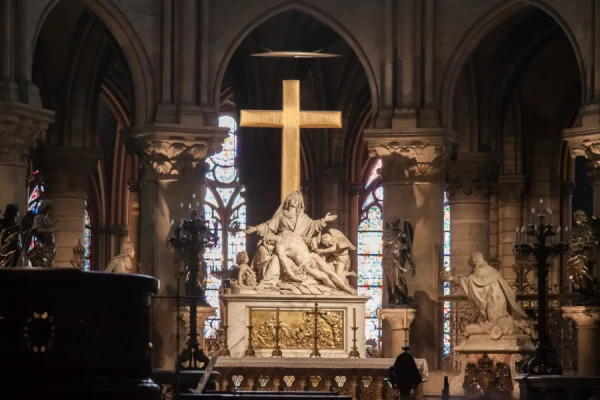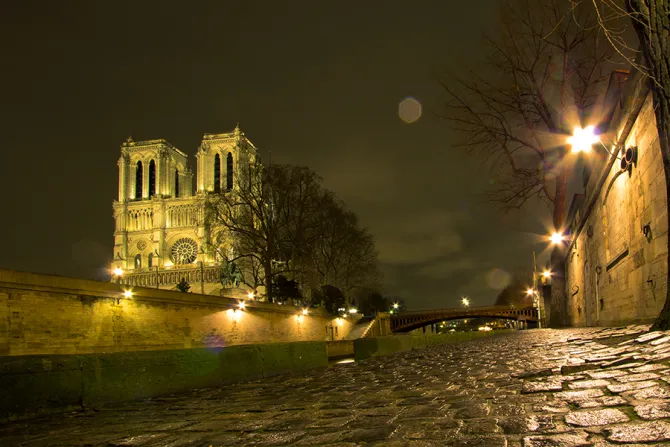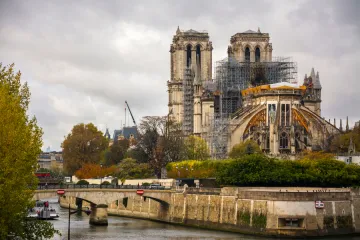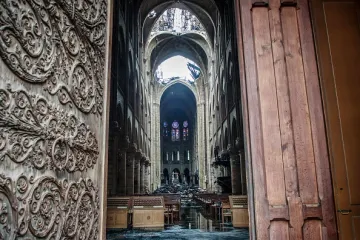Paris, France, Dec 10, 2021 / 05:00 am
France’s heritage authorities approved on Thursday controversial plans for the interior of Notre-Dame Cathedral in Paris.
Members of the National Heritage and Architecture Commission backed the proposals during a closed-door meeting on Dec. 9 amid an outcry over the restoration of the cathedral badly damaged by fire in 2019.
French media quoted the Ministry of Culture as saying that “the experts gave a favorable opinion on the interior refurbishment program.”
The commission expressed two reservations about the plan. The first concerned a proposal to remove saints’ statues in the chapels. The second related to plans to install moveable pews.
AFP reported that the commission asked to view a prototype of the pews, which would replace the current straw chairs.
The vote by a 24-member committee came shortly after more than 100 of France’s leading figures in the arts and academia criticized the proposals.
In an article published jointly by the magazine La Tribune de l’Art and newspaper Le Figaro on Dec. 7, they wrote: “The Archdiocese of Paris wants to take advantage of the restoration work to transform the interior of Notre-Dame into a project that completely distorts the decor and liturgical space.”
“It believes that the destruction caused by the fire is an opportunity to transform the visitor’s perception of the monument, even though the fire was limited to the roof and the spire and did not destroy any of the heritage inside.”

The signatories, who included television presenter Stéphane Bern and philosopher Alain Finkielkraut, added: “The project foresees the installation of removable benches, lighting that changes according to the seasons, video projections on the walls, etc., in other words, the same fashionable (and therefore already terribly outdated) ‘mediation devices’ that can be found in all ‘immersive’ cultural projects, in which silliness often vies with kitsch.”
The Daily Telegraph, a British newspaper, reported on Nov. 26 that critics feared the changes would turn the building into a “politically correct Disneyland.”
It said that “confessional boxes, altars, and classical sculptures will be replaced with modern art murals, and new sound and light effects to create ‘emotional spaces.’”
“There will be themed chapels on a ‘discovery trail,’ with an emphasis on Africa and Asia, while quotes from the Bible will be projected onto chapel walls in various languages, including Mandarin,” it added.
Maurice Culot, an architect who has seen the plans, told the newspaper: “It’s as if Disney were entering Notre-Dame.”
“What they are proposing to do to Notre-Dame would never be done to Westminster Abbey or St. Peter’s in Rome. It’s a kind of theme park and very childish and trivial given the grandeur of the place,” he commented.
But other experts have welcomed aspects of the plan. Writing in the Washington Post on Dec. 8, art historian Elizabeth Lev noted that the plan proposed the dedication of five chapels to five continents, with Bible verses projected in local languages.
(Story continues below)
“Perhaps this is what spawned the Disney comparison, a kind of Catholic Epcot Center,” she said. “But for an international icon in a city where 20% of residents are immigrants, what’s the problem with spreading a message of hope to every person who crosses that venerable threshold?”
“And while some have dubbed it ‘Christianity for Dummies,’ in a world where many Catholics are shaky on scripture and many young people are raised without religion, some back-to-basics catechetics might be in order.”
In an interview with AFP, Father Gilles Drouin, the priest overseeing the interior restoration, explained that the restoration sought to preserve the cathedral as a place of worship, but also to welcome and educate visitors “who are not always from a Christian culture.”
Drouin, the director of the Institut supérieur de liturgie at the Institut catholique de Paris, said that side chapels would feature “portraits from the 16th and 18th century that will be in dialogue with modern art objects.”
“The cathedral has always been open to art from the contemporary period, right up to the large golden cross by sculptor Marc Couturier installed by [the then archbishop of Paris] Cardinal Lustiger in 1994,” he said.
The French government is overseeing the cathedral’s structural restoration and conservation, but the cathedral authorities are responsible for its interior renewal.
The plans must ultimately be approved by France’s Ministry of Culture. Culture Minister Roselyne Bachelot has previously said that the restored cathedral should look “identical” to its form before the fire.
The cathedral will reportedly reopen for worship with a Te Deum on April 16, 2024, five years after the blaze. Later that year, Paris will host the Summer Olympics.
Speaking after the commission’s vote, Father Drouin told AFP: “We are very satisfied with this decision which respects the broad principles that we outlined, including the work on the lighting and the guidance for visitors.”






